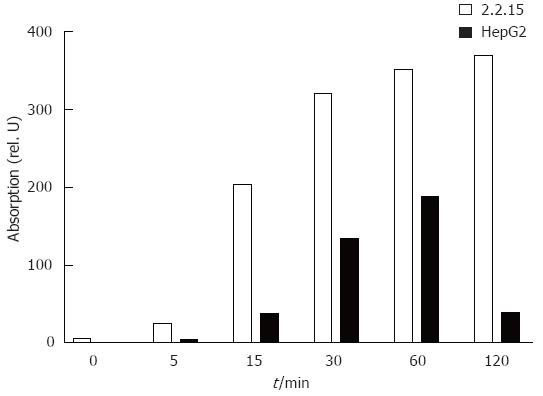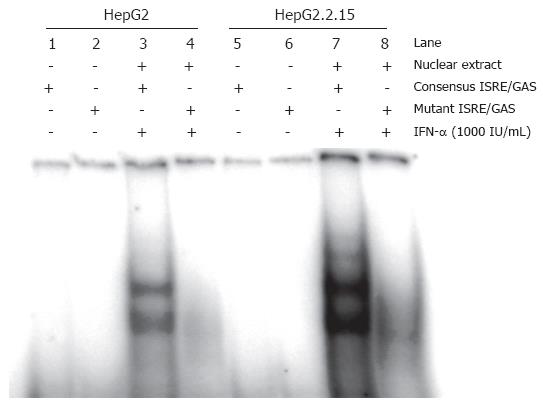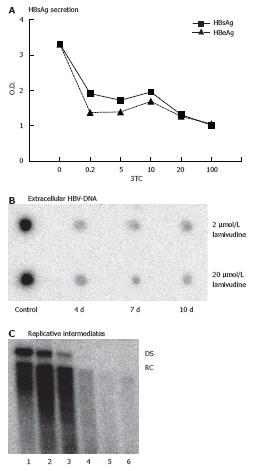Copyright
©2007 Baishideng Publishing Group Co.
World J Gastroenterol. Jan 14, 2007; 13(2): 228-235
Published online Jan 14, 2007. doi: 10.3748/wjg.v13.i2.228
Published online Jan 14, 2007. doi: 10.3748/wjg.v13.i2.228
Figure 1 Northern blot analysis of ISG expression and its modulation by lamivudine in HepG2 and HepG2.
2.15 cells. HepG2 and HepG2.2.15 cells were cultured in the absence or presence of 2 μmol/L of lamivudine for 10 d. Then, the cells were stimulated with 100 or 1000 IU/mL of IFN-α for 6 h. Total cellular RNAs were isolated for Northern blotting hybridization. Lam: lamivudine.
Figure 2 Analysis of Stat1 phosphorylation after IFN-α stimulation in HepG2 and HepG2.
2.15 cells. Cells were stimulated with 100 U/mL of IFN-α for the indicated time points. Then, nuclear proteins were extracted and analysed by western blot. Data were quantified using Imagequant and are shown as relative units.
Figure 3 Analysis of ISGF3 formation after IFN-α stimulation in HepG2 and HepG2.
2.15 cells. HepG2 and HepG2.2.15 cells were stimulated with 1000 IU/mL of IFN-α for 6 h followed by isolation of nuclear extracts (NE-PERTM reagent kits) for EMSA analysis.
Figure 4 Antiviral effects of lamivudine in HepG2.
2.15 cells. A: HepG2.2.15 cells were cultivated with various concentrations (0 to 100 μmol/L) of 3 TC for 10 d. Then, supernatants were harvested and assayed for the presence of HBsAg and HBeAg by ELISA; B: HepG2.2.15 cells were treated with 2 or 20 μmol/L of lamivudine for 4, 7 and 10 d, respectively. Then, supernatants were collected and extracellular HBV-DNA was analyzed by dot blot hybridization; C: HepG2.2.15 cells were treated with various concentrations of lamivudine for 10 d. Then, intracellular HBV replicative intermediates were isolated for southern blotting. Lane 1: control, lane 2: 0.04 μmol/L, lane 3: 0.2 μmol/L, lane 4: 5 μmol/L, lane 5: 25 μmol/L, lane 6: 125 μmol/L, RC, relaxed circular HBV-DNA; DS, double stranded linear HBV-DNA.
- Citation: Guan SH, Lu M, Grünewald P, Roggendorf M, Gerken G, Schlaak JF. Interferon-α response in chronic hepatitis B-transfected HepG2.2.15 cells is partially restored by lamivudine treatment. World J Gastroenterol 2007; 13(2): 228-235
- URL: https://www.wjgnet.com/1007-9327/full/v13/i2/228.htm
- DOI: https://dx.doi.org/10.3748/wjg.v13.i2.228












